BMO1102 VU: Organisational Behavior & Management in Global Context
VerifiedAdded on 2023/06/15
|12
|2845
|465
Essay
AI Summary
This essay discusses the impact of globalisation on organisational behaviour and management. It begins by defining global business and its significance, highlighting its benefits such as cost reduction, market expansion, and increased competitiveness. The essay then examines the phase model of globalisation, detailing the stages of exporting, cooperative contracts (licensing and franchising), strategic alliances (joint ventures), and wholly-owned affiliates, along with their respective strengths and weaknesses. Furthermore, the essay explores the challenges faced by firms operating in the international market, including legal, language, cultural, compliance, political, resource cost, and ethical issues. It concludes that while globalisation presents significant opportunities for businesses, it also poses considerable challenges that require effective strategies and careful planning to overcome.
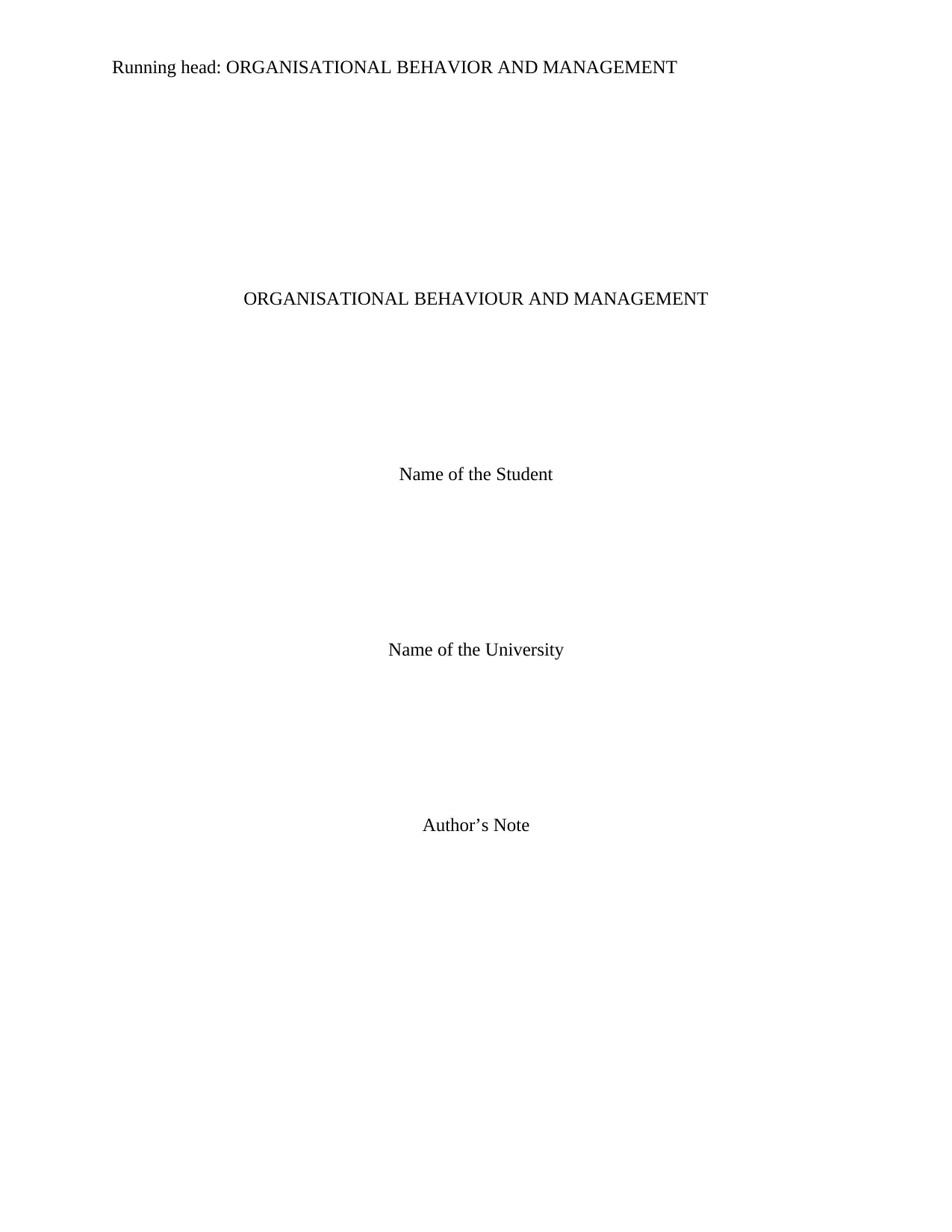
Running head: ORGANISATIONAL BEHAVIOR AND MANAGEMENT
ORGANISATIONAL BEHAVIOUR AND MANAGEMENT
Name of the Student
Name of the University
Author’s Note
ORGANISATIONAL BEHAVIOUR AND MANAGEMENT
Name of the Student
Name of the University
Author’s Note
Secure Best Marks with AI Grader
Need help grading? Try our AI Grader for instant feedback on your assignments.
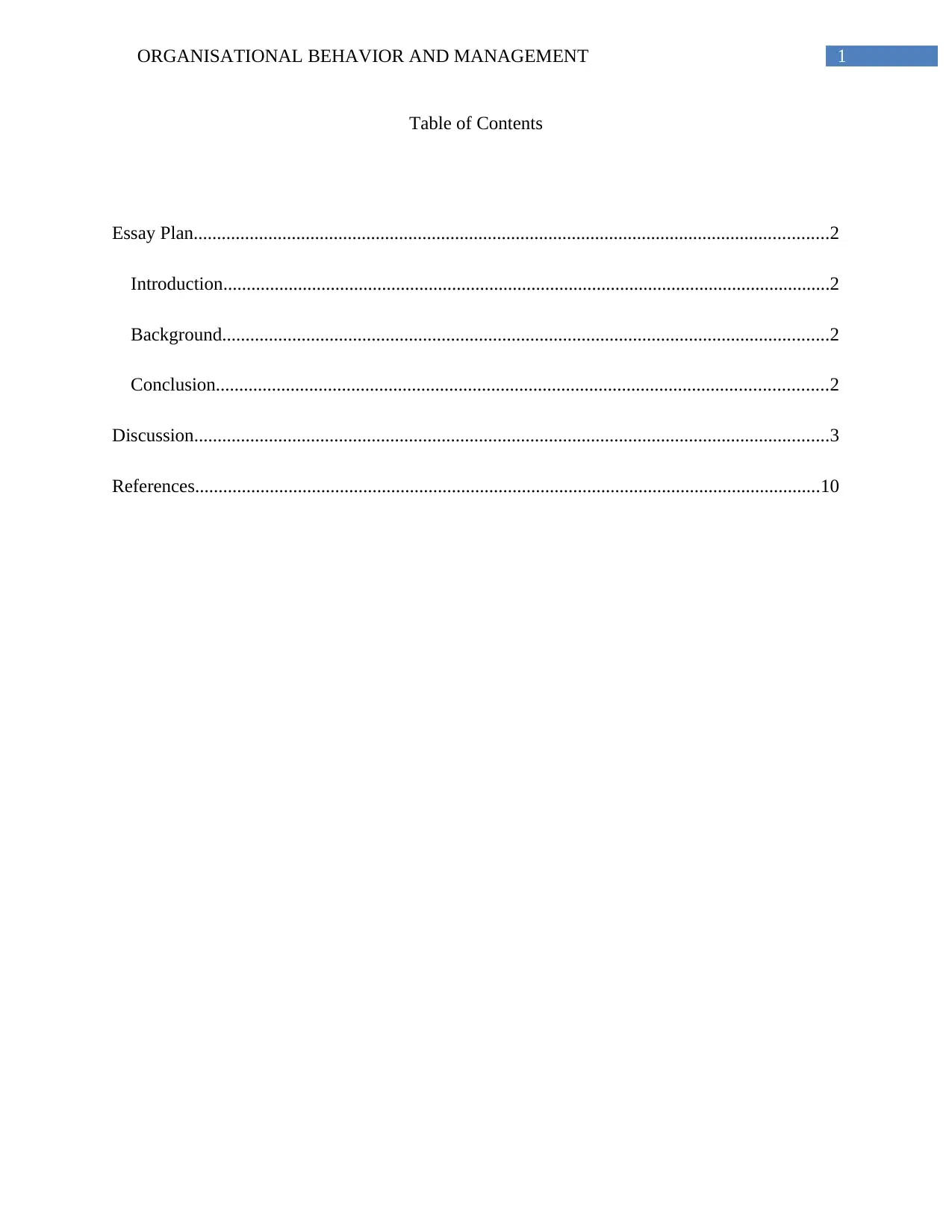
1ORGANISATIONAL BEHAVIOR AND MANAGEMENT
Table of Contents
Essay Plan........................................................................................................................................2
Introduction..................................................................................................................................2
Background..................................................................................................................................2
Conclusion...................................................................................................................................2
Discussion........................................................................................................................................3
References......................................................................................................................................10
Table of Contents
Essay Plan........................................................................................................................................2
Introduction..................................................................................................................................2
Background..................................................................................................................................2
Conclusion...................................................................................................................................2
Discussion........................................................................................................................................3
References......................................................................................................................................10
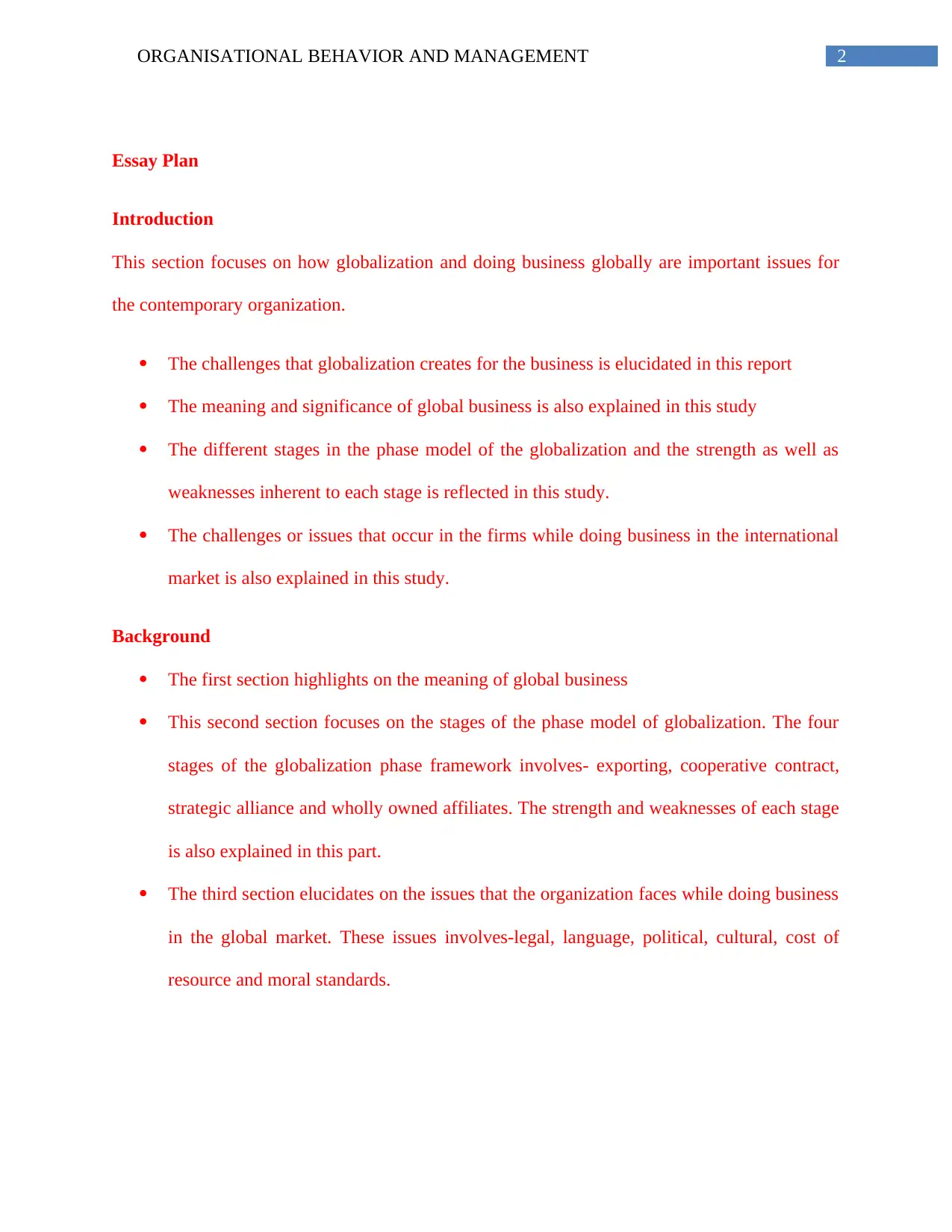
2ORGANISATIONAL BEHAVIOR AND MANAGEMENT
Essay Plan
Introduction
This section focuses on how globalization and doing business globally are important issues for
the contemporary organization.
The challenges that globalization creates for the business is elucidated in this report
The meaning and significance of global business is also explained in this study
The different stages in the phase model of the globalization and the strength as well as
weaknesses inherent to each stage is reflected in this study.
The challenges or issues that occur in the firms while doing business in the international
market is also explained in this study.
Background
The first section highlights on the meaning of global business
This second section focuses on the stages of the phase model of globalization. The four
stages of the globalization phase framework involves- exporting, cooperative contract,
strategic alliance and wholly owned affiliates. The strength and weaknesses of each stage
is also explained in this part.
The third section elucidates on the issues that the organization faces while doing business
in the global market. These issues involves-legal, language, political, cultural, cost of
resource and moral standards.
Essay Plan
Introduction
This section focuses on how globalization and doing business globally are important issues for
the contemporary organization.
The challenges that globalization creates for the business is elucidated in this report
The meaning and significance of global business is also explained in this study
The different stages in the phase model of the globalization and the strength as well as
weaknesses inherent to each stage is reflected in this study.
The challenges or issues that occur in the firms while doing business in the international
market is also explained in this study.
Background
The first section highlights on the meaning of global business
This second section focuses on the stages of the phase model of globalization. The four
stages of the globalization phase framework involves- exporting, cooperative contract,
strategic alliance and wholly owned affiliates. The strength and weaknesses of each stage
is also explained in this part.
The third section elucidates on the issues that the organization faces while doing business
in the global market. These issues involves-legal, language, political, cultural, cost of
resource and moral standards.
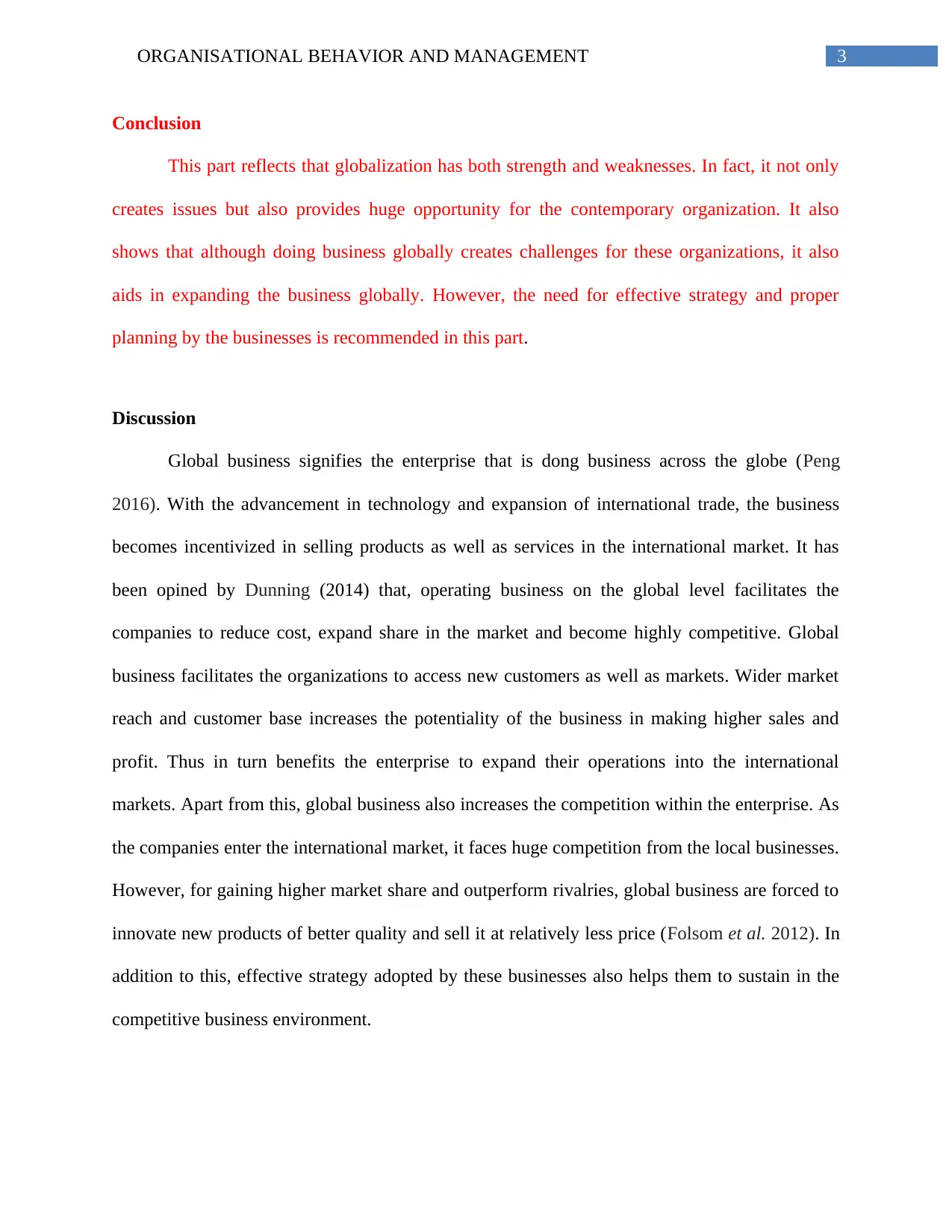
3ORGANISATIONAL BEHAVIOR AND MANAGEMENT
Conclusion
This part reflects that globalization has both strength and weaknesses. In fact, it not only
creates issues but also provides huge opportunity for the contemporary organization. It also
shows that although doing business globally creates challenges for these organizations, it also
aids in expanding the business globally. However, the need for effective strategy and proper
planning by the businesses is recommended in this part.
Discussion
Global business signifies the enterprise that is dong business across the globe (Peng
2016). With the advancement in technology and expansion of international trade, the business
becomes incentivized in selling products as well as services in the international market. It has
been opined by Dunning (2014) that, operating business on the global level facilitates the
companies to reduce cost, expand share in the market and become highly competitive. Global
business facilitates the organizations to access new customers as well as markets. Wider market
reach and customer base increases the potentiality of the business in making higher sales and
profit. Thus in turn benefits the enterprise to expand their operations into the international
markets. Apart from this, global business also increases the competition within the enterprise. As
the companies enter the international market, it faces huge competition from the local businesses.
However, for gaining higher market share and outperform rivalries, global business are forced to
innovate new products of better quality and sell it at relatively less price (Folsom et al. 2012). In
addition to this, effective strategy adopted by these businesses also helps them to sustain in the
competitive business environment.
Conclusion
This part reflects that globalization has both strength and weaknesses. In fact, it not only
creates issues but also provides huge opportunity for the contemporary organization. It also
shows that although doing business globally creates challenges for these organizations, it also
aids in expanding the business globally. However, the need for effective strategy and proper
planning by the businesses is recommended in this part.
Discussion
Global business signifies the enterprise that is dong business across the globe (Peng
2016). With the advancement in technology and expansion of international trade, the business
becomes incentivized in selling products as well as services in the international market. It has
been opined by Dunning (2014) that, operating business on the global level facilitates the
companies to reduce cost, expand share in the market and become highly competitive. Global
business facilitates the organizations to access new customers as well as markets. Wider market
reach and customer base increases the potentiality of the business in making higher sales and
profit. Thus in turn benefits the enterprise to expand their operations into the international
markets. Apart from this, global business also increases the competition within the enterprise. As
the companies enter the international market, it faces huge competition from the local businesses.
However, for gaining higher market share and outperform rivalries, global business are forced to
innovate new products of better quality and sell it at relatively less price (Folsom et al. 2012). In
addition to this, effective strategy adopted by these businesses also helps them to sustain in the
competitive business environment.
Secure Best Marks with AI Grader
Need help grading? Try our AI Grader for instant feedback on your assignments.
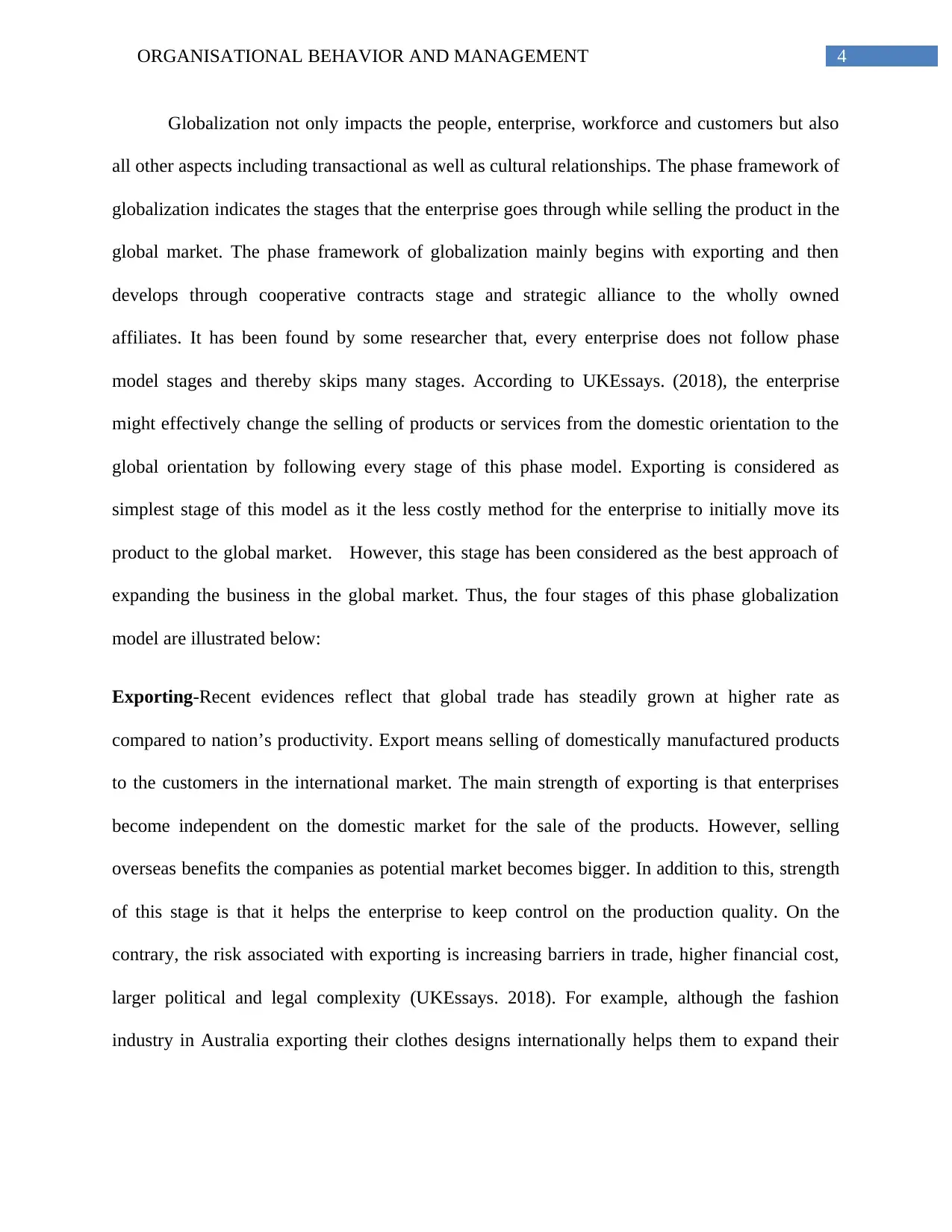
4ORGANISATIONAL BEHAVIOR AND MANAGEMENT
Globalization not only impacts the people, enterprise, workforce and customers but also
all other aspects including transactional as well as cultural relationships. The phase framework of
globalization indicates the stages that the enterprise goes through while selling the product in the
global market. The phase framework of globalization mainly begins with exporting and then
develops through cooperative contracts stage and strategic alliance to the wholly owned
affiliates. It has been found by some researcher that, every enterprise does not follow phase
model stages and thereby skips many stages. According to UKEssays. (2018), the enterprise
might effectively change the selling of products or services from the domestic orientation to the
global orientation by following every stage of this phase model. Exporting is considered as
simplest stage of this model as it the less costly method for the enterprise to initially move its
product to the global market. However, this stage has been considered as the best approach of
expanding the business in the global market. Thus, the four stages of this phase globalization
model are illustrated below:
Exporting-Recent evidences reflect that global trade has steadily grown at higher rate as
compared to nation’s productivity. Export means selling of domestically manufactured products
to the customers in the international market. The main strength of exporting is that enterprises
become independent on the domestic market for the sale of the products. However, selling
overseas benefits the companies as potential market becomes bigger. In addition to this, strength
of this stage is that it helps the enterprise to keep control on the production quality. On the
contrary, the risk associated with exporting is increasing barriers in trade, higher financial cost,
larger political and legal complexity (UKEssays. 2018). For example, although the fashion
industry in Australia exporting their clothes designs internationally helps them to expand their
Globalization not only impacts the people, enterprise, workforce and customers but also
all other aspects including transactional as well as cultural relationships. The phase framework of
globalization indicates the stages that the enterprise goes through while selling the product in the
global market. The phase framework of globalization mainly begins with exporting and then
develops through cooperative contracts stage and strategic alliance to the wholly owned
affiliates. It has been found by some researcher that, every enterprise does not follow phase
model stages and thereby skips many stages. According to UKEssays. (2018), the enterprise
might effectively change the selling of products or services from the domestic orientation to the
global orientation by following every stage of this phase model. Exporting is considered as
simplest stage of this model as it the less costly method for the enterprise to initially move its
product to the global market. However, this stage has been considered as the best approach of
expanding the business in the global market. Thus, the four stages of this phase globalization
model are illustrated below:
Exporting-Recent evidences reflect that global trade has steadily grown at higher rate as
compared to nation’s productivity. Export means selling of domestically manufactured products
to the customers in the international market. The main strength of exporting is that enterprises
become independent on the domestic market for the sale of the products. However, selling
overseas benefits the companies as potential market becomes bigger. In addition to this, strength
of this stage is that it helps the enterprise to keep control on the production quality. On the
contrary, the risk associated with exporting is increasing barriers in trade, higher financial cost,
larger political and legal complexity (UKEssays. 2018). For example, although the fashion
industry in Australia exporting their clothes designs internationally helps them to expand their
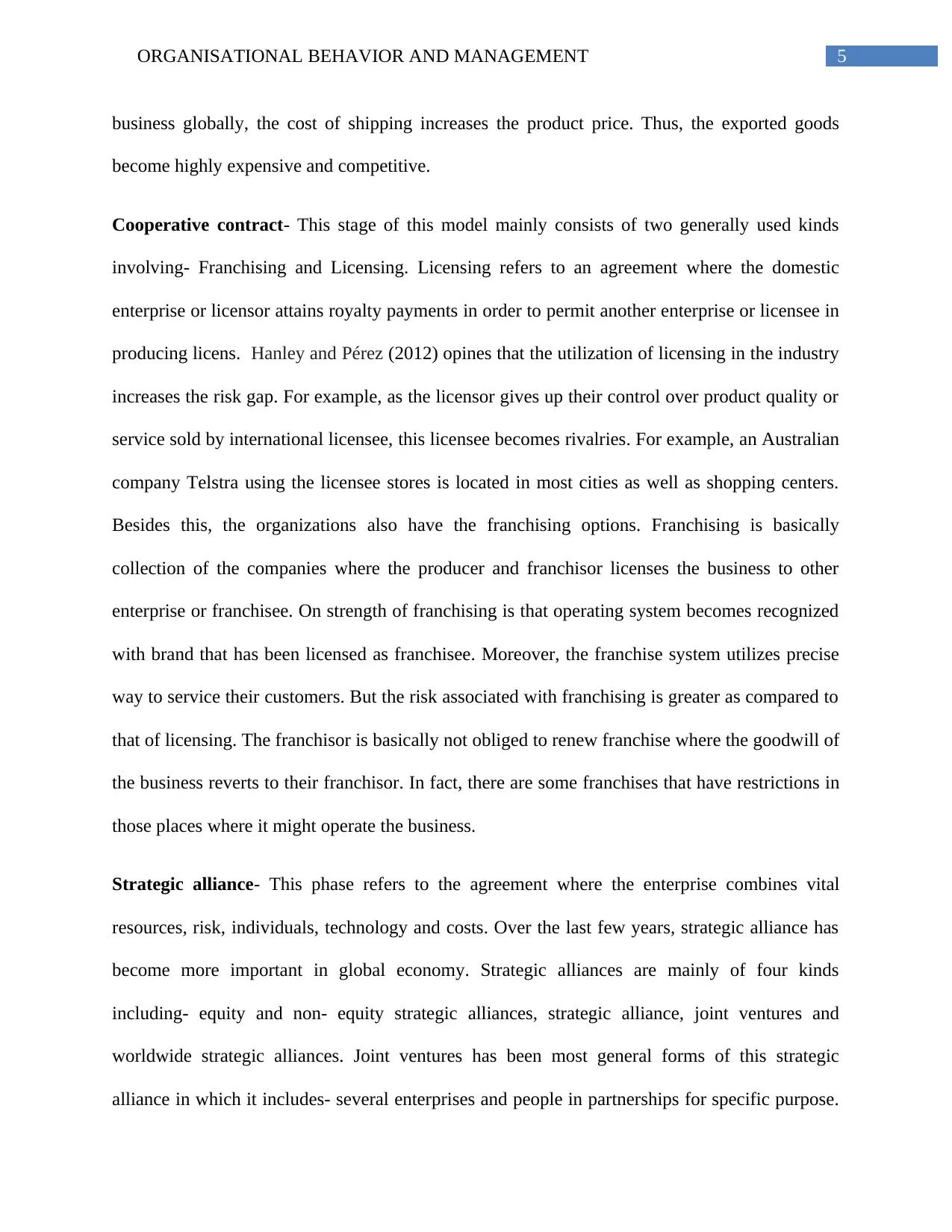
5ORGANISATIONAL BEHAVIOR AND MANAGEMENT
business globally, the cost of shipping increases the product price. Thus, the exported goods
become highly expensive and competitive.
Cooperative contract- This stage of this model mainly consists of two generally used kinds
involving- Franchising and Licensing. Licensing refers to an agreement where the domestic
enterprise or licensor attains royalty payments in order to permit another enterprise or licensee in
producing licens. Hanley and Pérez (2012) opines that the utilization of licensing in the industry
increases the risk gap. For example, as the licensor gives up their control over product quality or
service sold by international licensee, this licensee becomes rivalries. For example, an Australian
company Telstra using the licensee stores is located in most cities as well as shopping centers.
Besides this, the organizations also have the franchising options. Franchising is basically
collection of the companies where the producer and franchisor licenses the business to other
enterprise or franchisee. On strength of franchising is that operating system becomes recognized
with brand that has been licensed as franchisee. Moreover, the franchise system utilizes precise
way to service their customers. But the risk associated with franchising is greater as compared to
that of licensing. The franchisor is basically not obliged to renew franchise where the goodwill of
the business reverts to their franchisor. In fact, there are some franchises that have restrictions in
those places where it might operate the business.
Strategic alliance- This phase refers to the agreement where the enterprise combines vital
resources, risk, individuals, technology and costs. Over the last few years, strategic alliance has
become more important in global economy. Strategic alliances are mainly of four kinds
including- equity and non- equity strategic alliances, strategic alliance, joint ventures and
worldwide strategic alliances. Joint ventures has been most general forms of this strategic
alliance in which it includes- several enterprises and people in partnerships for specific purpose.
business globally, the cost of shipping increases the product price. Thus, the exported goods
become highly expensive and competitive.
Cooperative contract- This stage of this model mainly consists of two generally used kinds
involving- Franchising and Licensing. Licensing refers to an agreement where the domestic
enterprise or licensor attains royalty payments in order to permit another enterprise or licensee in
producing licens. Hanley and Pérez (2012) opines that the utilization of licensing in the industry
increases the risk gap. For example, as the licensor gives up their control over product quality or
service sold by international licensee, this licensee becomes rivalries. For example, an Australian
company Telstra using the licensee stores is located in most cities as well as shopping centers.
Besides this, the organizations also have the franchising options. Franchising is basically
collection of the companies where the producer and franchisor licenses the business to other
enterprise or franchisee. On strength of franchising is that operating system becomes recognized
with brand that has been licensed as franchisee. Moreover, the franchise system utilizes precise
way to service their customers. But the risk associated with franchising is greater as compared to
that of licensing. The franchisor is basically not obliged to renew franchise where the goodwill of
the business reverts to their franchisor. In fact, there are some franchises that have restrictions in
those places where it might operate the business.
Strategic alliance- This phase refers to the agreement where the enterprise combines vital
resources, risk, individuals, technology and costs. Over the last few years, strategic alliance has
become more important in global economy. Strategic alliances are mainly of four kinds
including- equity and non- equity strategic alliances, strategic alliance, joint ventures and
worldwide strategic alliances. Joint ventures has been most general forms of this strategic
alliance in which it includes- several enterprises and people in partnerships for specific purpose.
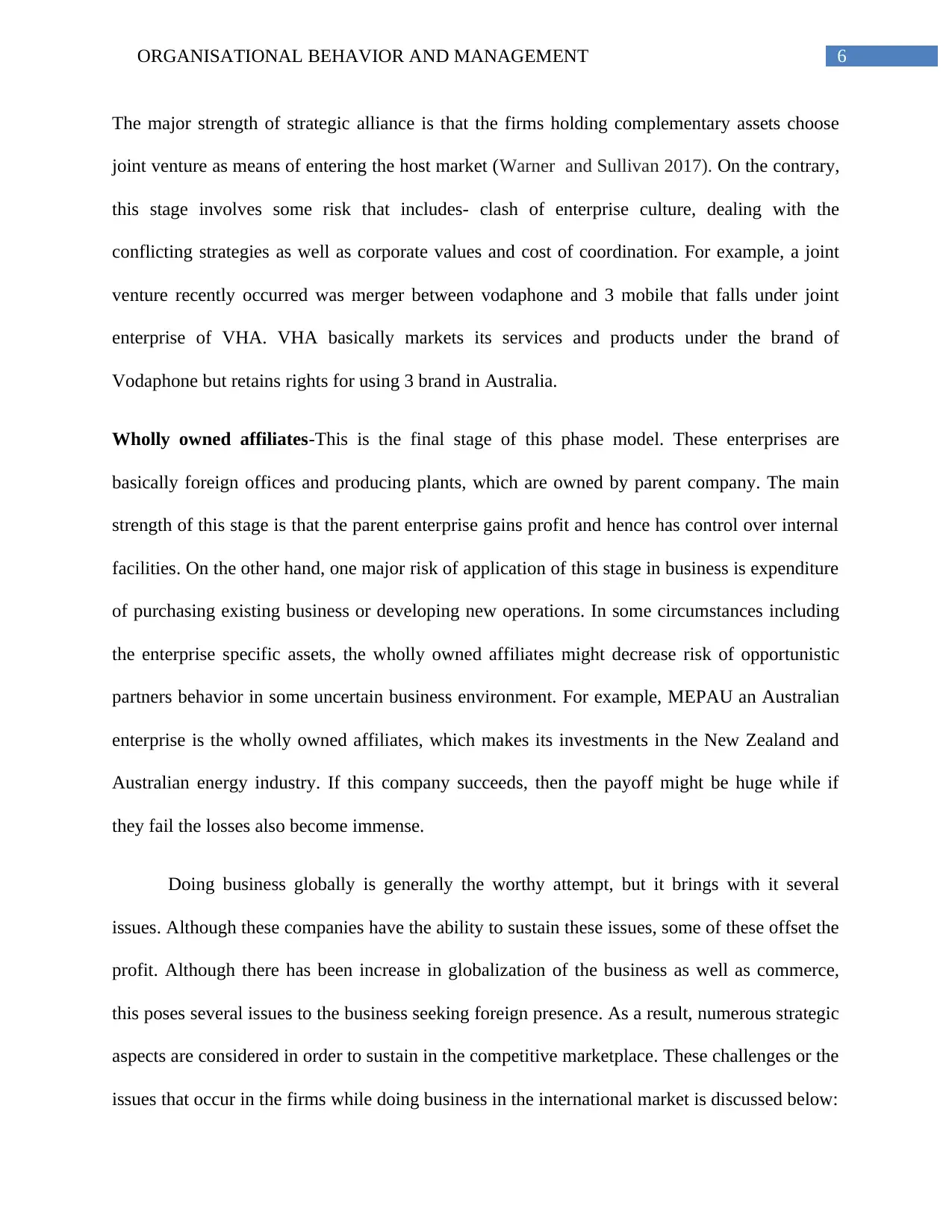
6ORGANISATIONAL BEHAVIOR AND MANAGEMENT
The major strength of strategic alliance is that the firms holding complementary assets choose
joint venture as means of entering the host market (Warner and Sullivan 2017). On the contrary,
this stage involves some risk that includes- clash of enterprise culture, dealing with the
conflicting strategies as well as corporate values and cost of coordination. For example, a joint
venture recently occurred was merger between vodaphone and 3 mobile that falls under joint
enterprise of VHA. VHA basically markets its services and products under the brand of
Vodaphone but retains rights for using 3 brand in Australia.
Wholly owned affiliates-This is the final stage of this phase model. These enterprises are
basically foreign offices and producing plants, which are owned by parent company. The main
strength of this stage is that the parent enterprise gains profit and hence has control over internal
facilities. On the other hand, one major risk of application of this stage in business is expenditure
of purchasing existing business or developing new operations. In some circumstances including
the enterprise specific assets, the wholly owned affiliates might decrease risk of opportunistic
partners behavior in some uncertain business environment. For example, MEPAU an Australian
enterprise is the wholly owned affiliates, which makes its investments in the New Zealand and
Australian energy industry. If this company succeeds, then the payoff might be huge while if
they fail the losses also become immense.
Doing business globally is generally the worthy attempt, but it brings with it several
issues. Although these companies have the ability to sustain these issues, some of these offset the
profit. Although there has been increase in globalization of the business as well as commerce,
this poses several issues to the business seeking foreign presence. As a result, numerous strategic
aspects are considered in order to sustain in the competitive marketplace. These challenges or the
issues that occur in the firms while doing business in the international market is discussed below:
The major strength of strategic alliance is that the firms holding complementary assets choose
joint venture as means of entering the host market (Warner and Sullivan 2017). On the contrary,
this stage involves some risk that includes- clash of enterprise culture, dealing with the
conflicting strategies as well as corporate values and cost of coordination. For example, a joint
venture recently occurred was merger between vodaphone and 3 mobile that falls under joint
enterprise of VHA. VHA basically markets its services and products under the brand of
Vodaphone but retains rights for using 3 brand in Australia.
Wholly owned affiliates-This is the final stage of this phase model. These enterprises are
basically foreign offices and producing plants, which are owned by parent company. The main
strength of this stage is that the parent enterprise gains profit and hence has control over internal
facilities. On the other hand, one major risk of application of this stage in business is expenditure
of purchasing existing business or developing new operations. In some circumstances including
the enterprise specific assets, the wholly owned affiliates might decrease risk of opportunistic
partners behavior in some uncertain business environment. For example, MEPAU an Australian
enterprise is the wholly owned affiliates, which makes its investments in the New Zealand and
Australian energy industry. If this company succeeds, then the payoff might be huge while if
they fail the losses also become immense.
Doing business globally is generally the worthy attempt, but it brings with it several
issues. Although these companies have the ability to sustain these issues, some of these offset the
profit. Although there has been increase in globalization of the business as well as commerce,
this poses several issues to the business seeking foreign presence. As a result, numerous strategic
aspects are considered in order to sustain in the competitive marketplace. These challenges or the
issues that occur in the firms while doing business in the international market is discussed below:
Paraphrase This Document
Need a fresh take? Get an instant paraphrase of this document with our AI Paraphraser
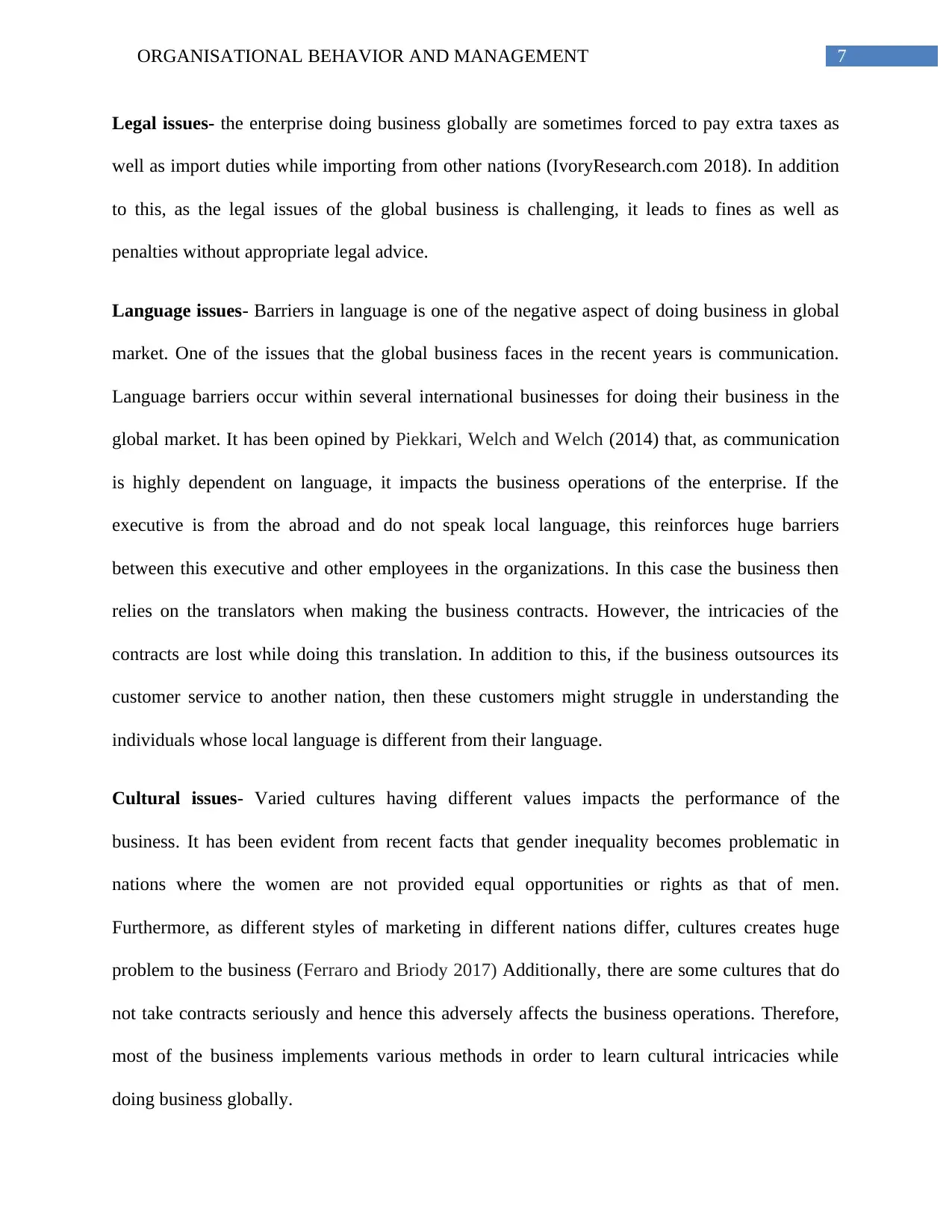
7ORGANISATIONAL BEHAVIOR AND MANAGEMENT
Legal issues- the enterprise doing business globally are sometimes forced to pay extra taxes as
well as import duties while importing from other nations (IvoryResearch.com 2018). In addition
to this, as the legal issues of the global business is challenging, it leads to fines as well as
penalties without appropriate legal advice.
Language issues- Barriers in language is one of the negative aspect of doing business in global
market. One of the issues that the global business faces in the recent years is communication.
Language barriers occur within several international businesses for doing their business in the
global market. It has been opined by Piekkari, Welch and Welch (2014) that, as communication
is highly dependent on language, it impacts the business operations of the enterprise. If the
executive is from the abroad and do not speak local language, this reinforces huge barriers
between this executive and other employees in the organizations. In this case the business then
relies on the translators when making the business contracts. However, the intricacies of the
contracts are lost while doing this translation. In addition to this, if the business outsources its
customer service to another nation, then these customers might struggle in understanding the
individuals whose local language is different from their language.
Cultural issues- Varied cultures having different values impacts the performance of the
business. It has been evident from recent facts that gender inequality becomes problematic in
nations where the women are not provided equal opportunities or rights as that of men.
Furthermore, as different styles of marketing in different nations differ, cultures creates huge
problem to the business (Ferraro and Briody 2017) Additionally, there are some cultures that do
not take contracts seriously and hence this adversely affects the business operations. Therefore,
most of the business implements various methods in order to learn cultural intricacies while
doing business globally.
Legal issues- the enterprise doing business globally are sometimes forced to pay extra taxes as
well as import duties while importing from other nations (IvoryResearch.com 2018). In addition
to this, as the legal issues of the global business is challenging, it leads to fines as well as
penalties without appropriate legal advice.
Language issues- Barriers in language is one of the negative aspect of doing business in global
market. One of the issues that the global business faces in the recent years is communication.
Language barriers occur within several international businesses for doing their business in the
global market. It has been opined by Piekkari, Welch and Welch (2014) that, as communication
is highly dependent on language, it impacts the business operations of the enterprise. If the
executive is from the abroad and do not speak local language, this reinforces huge barriers
between this executive and other employees in the organizations. In this case the business then
relies on the translators when making the business contracts. However, the intricacies of the
contracts are lost while doing this translation. In addition to this, if the business outsources its
customer service to another nation, then these customers might struggle in understanding the
individuals whose local language is different from their language.
Cultural issues- Varied cultures having different values impacts the performance of the
business. It has been evident from recent facts that gender inequality becomes problematic in
nations where the women are not provided equal opportunities or rights as that of men.
Furthermore, as different styles of marketing in different nations differ, cultures creates huge
problem to the business (Ferraro and Briody 2017) Additionally, there are some cultures that do
not take contracts seriously and hence this adversely affects the business operations. Therefore,
most of the business implements various methods in order to learn cultural intricacies while
doing business globally.
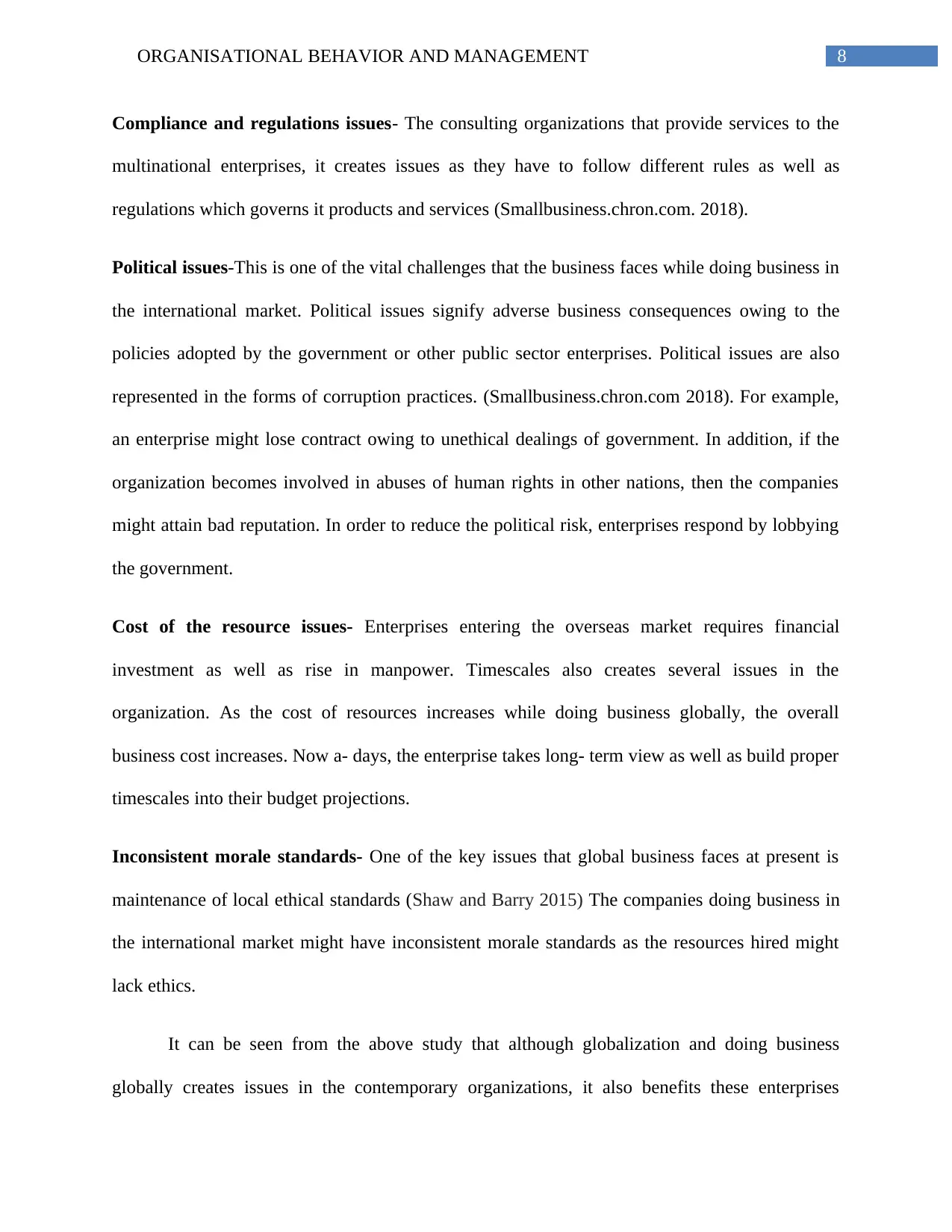
8ORGANISATIONAL BEHAVIOR AND MANAGEMENT
Compliance and regulations issues- The consulting organizations that provide services to the
multinational enterprises, it creates issues as they have to follow different rules as well as
regulations which governs it products and services (Smallbusiness.chron.com. 2018).
Political issues-This is one of the vital challenges that the business faces while doing business in
the international market. Political issues signify adverse business consequences owing to the
policies adopted by the government or other public sector enterprises. Political issues are also
represented in the forms of corruption practices. (Smallbusiness.chron.com 2018). For example,
an enterprise might lose contract owing to unethical dealings of government. In addition, if the
organization becomes involved in abuses of human rights in other nations, then the companies
might attain bad reputation. In order to reduce the political risk, enterprises respond by lobbying
the government.
Cost of the resource issues- Enterprises entering the overseas market requires financial
investment as well as rise in manpower. Timescales also creates several issues in the
organization. As the cost of resources increases while doing business globally, the overall
business cost increases. Now a- days, the enterprise takes long- term view as well as build proper
timescales into their budget projections.
Inconsistent morale standards- One of the key issues that global business faces at present is
maintenance of local ethical standards (Shaw and Barry 2015) The companies doing business in
the international market might have inconsistent morale standards as the resources hired might
lack ethics.
It can be seen from the above study that although globalization and doing business
globally creates issues in the contemporary organizations, it also benefits these enterprises
Compliance and regulations issues- The consulting organizations that provide services to the
multinational enterprises, it creates issues as they have to follow different rules as well as
regulations which governs it products and services (Smallbusiness.chron.com. 2018).
Political issues-This is one of the vital challenges that the business faces while doing business in
the international market. Political issues signify adverse business consequences owing to the
policies adopted by the government or other public sector enterprises. Political issues are also
represented in the forms of corruption practices. (Smallbusiness.chron.com 2018). For example,
an enterprise might lose contract owing to unethical dealings of government. In addition, if the
organization becomes involved in abuses of human rights in other nations, then the companies
might attain bad reputation. In order to reduce the political risk, enterprises respond by lobbying
the government.
Cost of the resource issues- Enterprises entering the overseas market requires financial
investment as well as rise in manpower. Timescales also creates several issues in the
organization. As the cost of resources increases while doing business globally, the overall
business cost increases. Now a- days, the enterprise takes long- term view as well as build proper
timescales into their budget projections.
Inconsistent morale standards- One of the key issues that global business faces at present is
maintenance of local ethical standards (Shaw and Barry 2015) The companies doing business in
the international market might have inconsistent morale standards as the resources hired might
lack ethics.
It can be seen from the above study that although globalization and doing business
globally creates issues in the contemporary organizations, it also benefits these enterprises
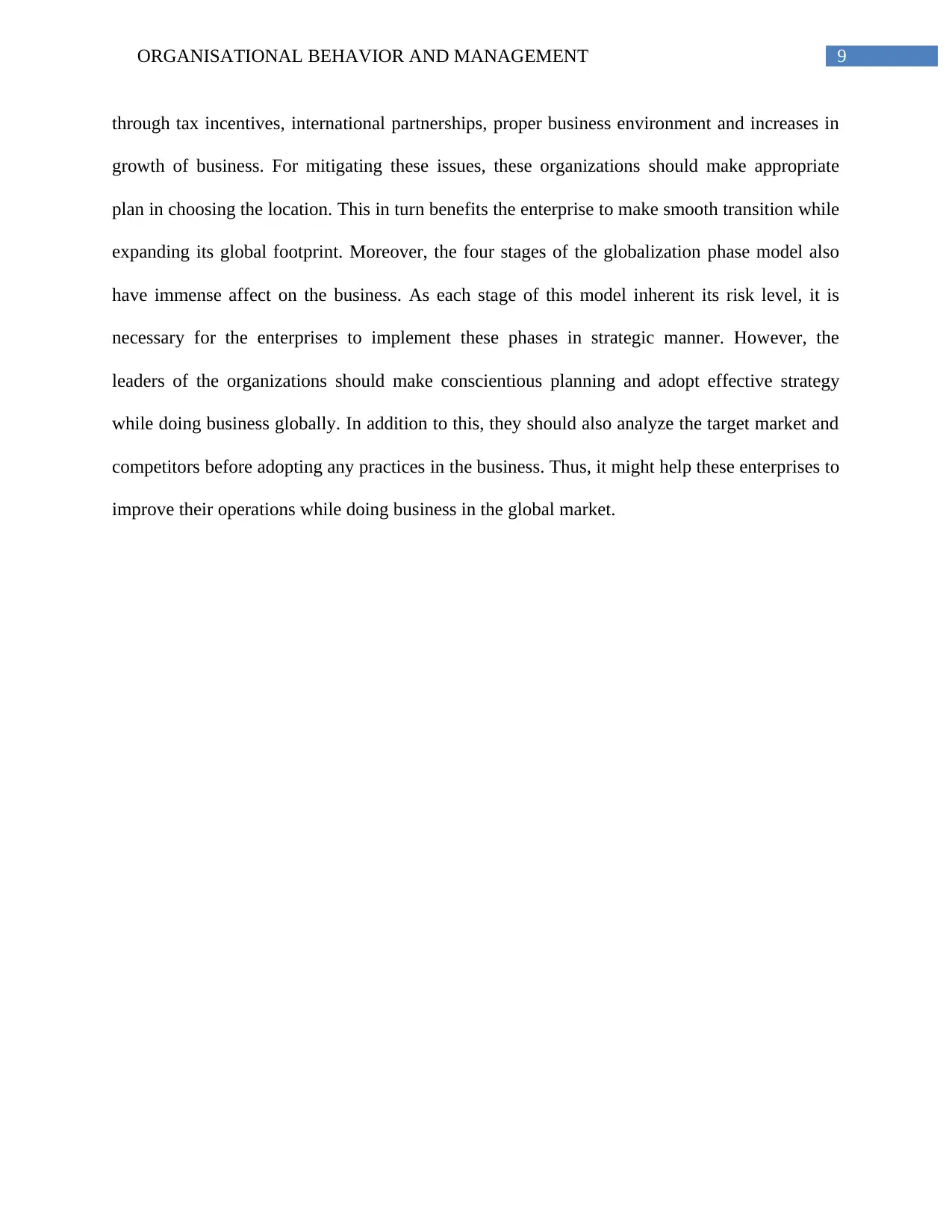
9ORGANISATIONAL BEHAVIOR AND MANAGEMENT
through tax incentives, international partnerships, proper business environment and increases in
growth of business. For mitigating these issues, these organizations should make appropriate
plan in choosing the location. This in turn benefits the enterprise to make smooth transition while
expanding its global footprint. Moreover, the four stages of the globalization phase model also
have immense affect on the business. As each stage of this model inherent its risk level, it is
necessary for the enterprises to implement these phases in strategic manner. However, the
leaders of the organizations should make conscientious planning and adopt effective strategy
while doing business globally. In addition to this, they should also analyze the target market and
competitors before adopting any practices in the business. Thus, it might help these enterprises to
improve their operations while doing business in the global market.
through tax incentives, international partnerships, proper business environment and increases in
growth of business. For mitigating these issues, these organizations should make appropriate
plan in choosing the location. This in turn benefits the enterprise to make smooth transition while
expanding its global footprint. Moreover, the four stages of the globalization phase model also
have immense affect on the business. As each stage of this model inherent its risk level, it is
necessary for the enterprises to implement these phases in strategic manner. However, the
leaders of the organizations should make conscientious planning and adopt effective strategy
while doing business globally. In addition to this, they should also analyze the target market and
competitors before adopting any practices in the business. Thus, it might help these enterprises to
improve their operations while doing business in the global market.
Secure Best Marks with AI Grader
Need help grading? Try our AI Grader for instant feedback on your assignments.
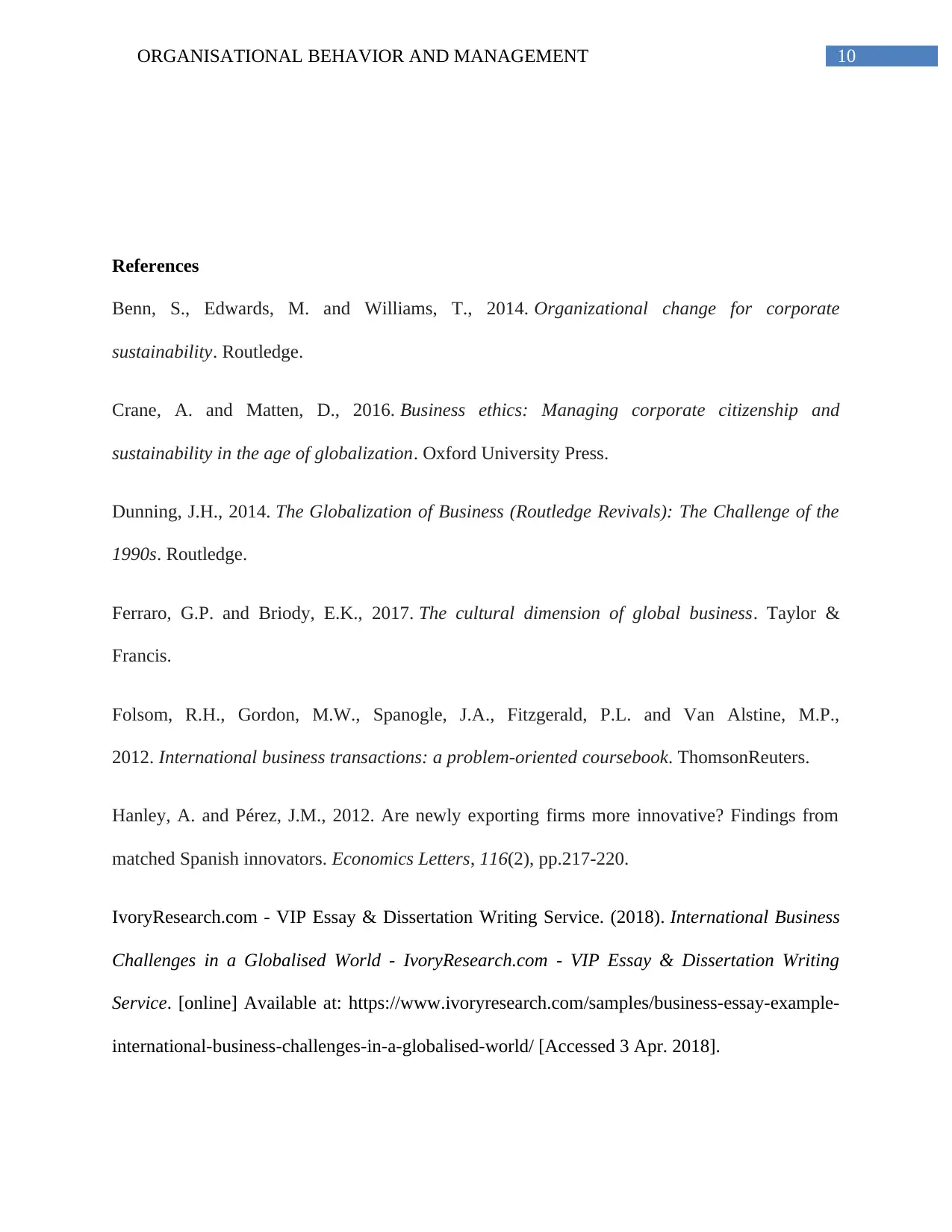
10ORGANISATIONAL BEHAVIOR AND MANAGEMENT
References
Benn, S., Edwards, M. and Williams, T., 2014. Organizational change for corporate
sustainability. Routledge.
Crane, A. and Matten, D., 2016. Business ethics: Managing corporate citizenship and
sustainability in the age of globalization. Oxford University Press.
Dunning, J.H., 2014. The Globalization of Business (Routledge Revivals): The Challenge of the
1990s. Routledge.
Ferraro, G.P. and Briody, E.K., 2017. The cultural dimension of global business. Taylor &
Francis.
Folsom, R.H., Gordon, M.W., Spanogle, J.A., Fitzgerald, P.L. and Van Alstine, M.P.,
2012. International business transactions: a problem-oriented coursebook. ThomsonReuters.
Hanley, A. and Pérez, J.M., 2012. Are newly exporting firms more innovative? Findings from
matched Spanish innovators. Economics Letters, 116(2), pp.217-220.
IvoryResearch.com - VIP Essay & Dissertation Writing Service. (2018). International Business
Challenges in a Globalised World - IvoryResearch.com - VIP Essay & Dissertation Writing
Service. [online] Available at: https://www.ivoryresearch.com/samples/business-essay-example-
international-business-challenges-in-a-globalised-world/ [Accessed 3 Apr. 2018].
References
Benn, S., Edwards, M. and Williams, T., 2014. Organizational change for corporate
sustainability. Routledge.
Crane, A. and Matten, D., 2016. Business ethics: Managing corporate citizenship and
sustainability in the age of globalization. Oxford University Press.
Dunning, J.H., 2014. The Globalization of Business (Routledge Revivals): The Challenge of the
1990s. Routledge.
Ferraro, G.P. and Briody, E.K., 2017. The cultural dimension of global business. Taylor &
Francis.
Folsom, R.H., Gordon, M.W., Spanogle, J.A., Fitzgerald, P.L. and Van Alstine, M.P.,
2012. International business transactions: a problem-oriented coursebook. ThomsonReuters.
Hanley, A. and Pérez, J.M., 2012. Are newly exporting firms more innovative? Findings from
matched Spanish innovators. Economics Letters, 116(2), pp.217-220.
IvoryResearch.com - VIP Essay & Dissertation Writing Service. (2018). International Business
Challenges in a Globalised World - IvoryResearch.com - VIP Essay & Dissertation Writing
Service. [online] Available at: https://www.ivoryresearch.com/samples/business-essay-example-
international-business-challenges-in-a-globalised-world/ [Accessed 3 Apr. 2018].
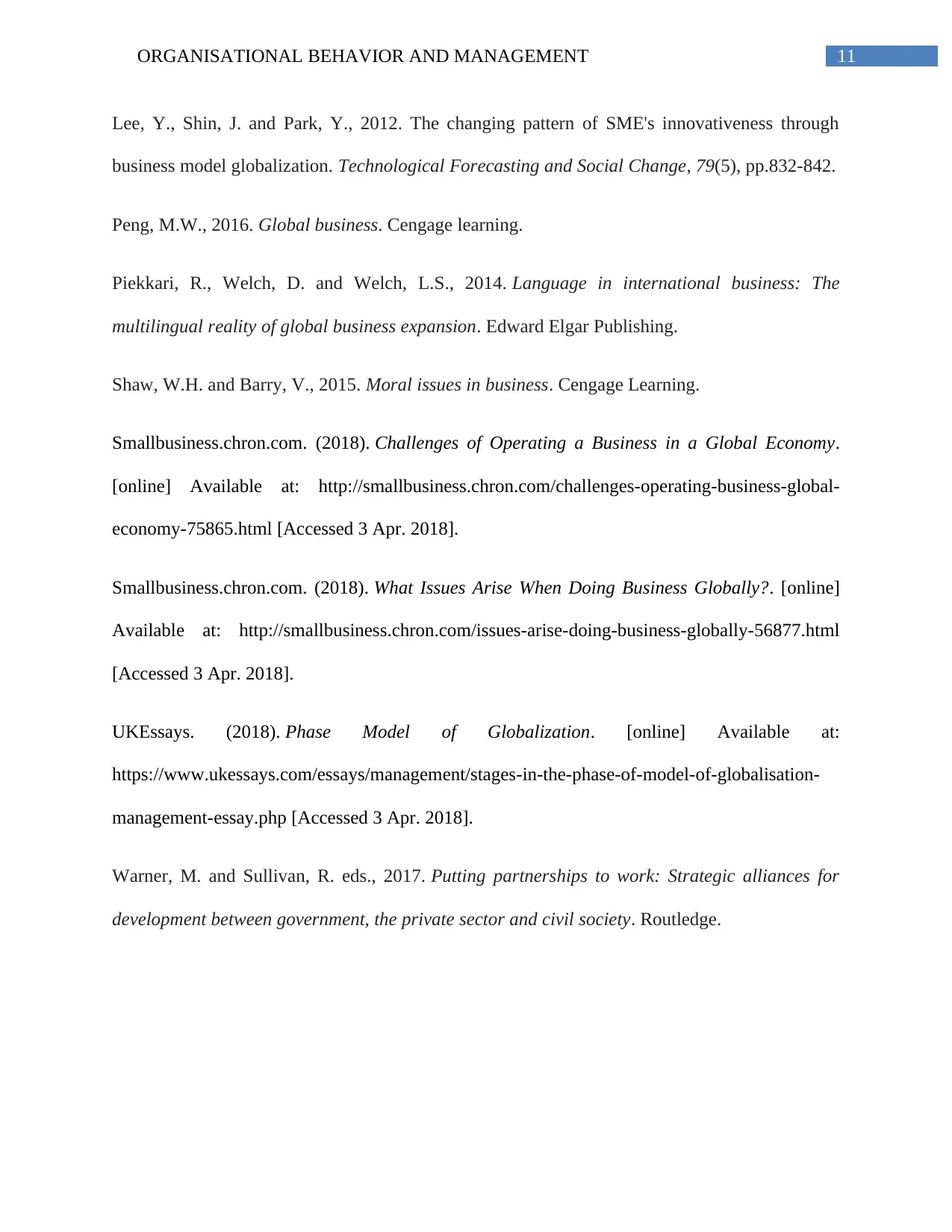
11ORGANISATIONAL BEHAVIOR AND MANAGEMENT
Lee, Y., Shin, J. and Park, Y., 2012. The changing pattern of SME's innovativeness through
business model globalization. Technological Forecasting and Social Change, 79(5), pp.832-842.
Peng, M.W., 2016. Global business. Cengage learning.
Piekkari, R., Welch, D. and Welch, L.S., 2014. Language in international business: The
multilingual reality of global business expansion. Edward Elgar Publishing.
Shaw, W.H. and Barry, V., 2015. Moral issues in business. Cengage Learning.
Smallbusiness.chron.com. (2018). Challenges of Operating a Business in a Global Economy.
[online] Available at: http://smallbusiness.chron.com/challenges-operating-business-global-
economy-75865.html [Accessed 3 Apr. 2018].
Smallbusiness.chron.com. (2018). What Issues Arise When Doing Business Globally?. [online]
Available at: http://smallbusiness.chron.com/issues-arise-doing-business-globally-56877.html
[Accessed 3 Apr. 2018].
UKEssays. (2018). Phase Model of Globalization. [online] Available at:
https://www.ukessays.com/essays/management/stages-in-the-phase-of-model-of-globalisation-
management-essay.php [Accessed 3 Apr. 2018].
Warner, M. and Sullivan, R. eds., 2017. Putting partnerships to work: Strategic alliances for
development between government, the private sector and civil society. Routledge.
Lee, Y., Shin, J. and Park, Y., 2012. The changing pattern of SME's innovativeness through
business model globalization. Technological Forecasting and Social Change, 79(5), pp.832-842.
Peng, M.W., 2016. Global business. Cengage learning.
Piekkari, R., Welch, D. and Welch, L.S., 2014. Language in international business: The
multilingual reality of global business expansion. Edward Elgar Publishing.
Shaw, W.H. and Barry, V., 2015. Moral issues in business. Cengage Learning.
Smallbusiness.chron.com. (2018). Challenges of Operating a Business in a Global Economy.
[online] Available at: http://smallbusiness.chron.com/challenges-operating-business-global-
economy-75865.html [Accessed 3 Apr. 2018].
Smallbusiness.chron.com. (2018). What Issues Arise When Doing Business Globally?. [online]
Available at: http://smallbusiness.chron.com/issues-arise-doing-business-globally-56877.html
[Accessed 3 Apr. 2018].
UKEssays. (2018). Phase Model of Globalization. [online] Available at:
https://www.ukessays.com/essays/management/stages-in-the-phase-of-model-of-globalisation-
management-essay.php [Accessed 3 Apr. 2018].
Warner, M. and Sullivan, R. eds., 2017. Putting partnerships to work: Strategic alliances for
development between government, the private sector and civil society. Routledge.
1 out of 12
Related Documents
Your All-in-One AI-Powered Toolkit for Academic Success.
+13062052269
info@desklib.com
Available 24*7 on WhatsApp / Email
![[object Object]](/_next/static/media/star-bottom.7253800d.svg)
Unlock your academic potential
© 2024 | Zucol Services PVT LTD | All rights reserved.




